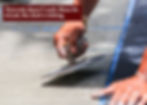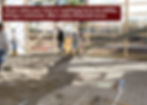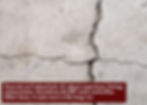Concrete Pouring: Should You DIY or Hire a Pro?
- Gra-Rock
- Aug 25
- 9 min read
Updated: Sep 9
You’ve got a project in mind. Maybe it’s a new patio, a shed foundation, or finally replacing that cracked sidewalk. You’re handy. Motivated. Ready to roll up your sleeves and finally get it done.
Concrete? Seems simple enough. Just mix, pour, smooth, and boom—you’re grilling by Saturday.
But here’s the thing…
Concrete isn’t forgiving. Mess up the mix? It cracks. Work too slow? It sets before you finish. Get the slope wrong? Water pools right next to your house.
What started as a money-saving weekend project can quickly turn into a costly redo.
So here’s the real question: Should you pour concrete yourself—or hire a professional?
That’s where we come in.
At Gra-Rock, we’ve helped hundreds of homeowners like you—people who care about doing the job right, whether they tackle it solo or bring in backup. This guide will walk you through the pros, cons, costs, risks, and results of both options.
We’re not here to push you one way or the other. We’re here to help you pour with confidence.
Let’s get into it.

Not enough time to read? Here's a TL;DR:
DIY Appeal: Doing it yourself can save money and provide personal satisfaction, especially for small projects like stepping stones.
The DIY Challenge: Pouring concrete is physically demanding and complex. Mistakes in mixing, leveling, or curing can lead to costly failures that need to be redone.
Benefits of a Pro: Hiring a professional is the smarter choice for larger projects, structural jobs, or if you want a decorative finish. Pros have the right equipment and experience to ensure a quality result.
Final Cost Consideration: While DIY seems cheaper, the cost of tool rentals and the risk of mistakes can make the final price comparable to hiring a professional.
Interested in learning more? Keep reading below!
The Appeal of DIY Concrete Pouring
There’s something satisfying about doing a job yourself. Especially when it saves you money.
And concrete? At first glance, it doesn’t look that complicated. No electrical. No plumbing. No permits in most cases. Just dirt, gravel, and cement mix.
That’s what draws so many homeowners in. The project feels doable. The materials are accessible. And the pride of saying, “I poured that,” is hard to beat.
So why not go for it?
Here’s what makes DIY concrete pouring appealing:
Cost savings – You’re not paying for labor, just materials and tool rentals.
Flexibility – Work at your own pace, on your own schedule.
Personal satisfaction – There’s nothing quite like seeing your own work set in stone—literally.
Greater control – Doing a project yourself gives you the ability to shape and mold it to your precise liking.

For small projects like stepping stones, a trash can pad, or a basic backyard slab, DIY can absolutely make sense.
But—and this is a big one—concrete isn’t as forgiving as it looks. Even a basic pour has several layers of complexity. And once it’s set, there’s no going back.
Let’s take a closer look at what a DIY job actually involves.
What DIY Concrete Work Really Involves
If you’re thinking of tackling a concrete project yourself, it’s helpful to know exactly what you’re signing up for.
Here’s a rough breakdown of the steps:
Site prep – Measure your space, mark it out, and excavate the area. This might mean removing grass, topsoil, or old concrete. You'll need a level subgrade to build on.
Build forms – Construct wooden frames (usually with 2x4s or 2x6s) that outline the shape of your slab. They need to be level and firmly staked into place.
Add a base layer – Pour in a layer of compacted gravel or crushed stone. This helps with drainage and stabilizes the slab. Some people also add a layer of sand.
Reinforce – Depending on your project size, you might need wire mesh or rebar to prevent cracking over time.
Mix and pour – If you're not getting ready-mix delivered, you’ll need to mix bags of concrete yourself. That means a mixer, lots of water, and hauling heavy loads. Once it’s mixed, you’ve got to move fast.

Screed and level – After the pour, you’ll drag a long board across the surface to level the concrete and remove excess.
Float and edge – This is where the finish begins. You’ll smooth the surface with a bull float, then run an edger along the borders for a clean look.
Create a surface finish – Broom finish? Smooth trowel? Stamped? Each takes a different tool and touch.
Control joints – These prevent cracking. You can use a groover tool or saw cut after curing.
Cure the slab – Concrete doesn’t fully dry—it cures. That means keeping it moist and protected from heat and rain for several days.
It’s a lot, right?
That’s why many DIYers start with confidence but end up frustrated halfway through. Concrete doesn’t wait. Once it’s mixed, the clock is ticking.

Next, let’s talk about where things often go sideways.
Where DIY Concrete Projects Often Go Wrong
Concrete isn’t a flexible friend. It’s stubborn. Once it starts setting, you have minutes to fix mistakes—not hours. That’s why even small errors in the early stages can leave you with cracks, uneven surfaces, or a slab that drains the wrong direction.
Here are some of the most common missteps:
Improper mixing – Too much water makes weak concrete. Not enough, and it won’t flow. The right consistency is key.
Pouring too slowly – Concrete starts curing as soon as it’s mixed. If you're working alone or without enough help, you might not finish in time.
Bad leveling – If your screed technique is off, you’ll end up with a lumpy or sloped surface.
Skipping reinforcement – Rebar or mesh prevents shifting and cracking. Without it, even small slabs can break apart over time.
Poor curing – Curing isn't just a formality. If concrete dries too fast or isn't kept moist, it can flake, chalk, or crack prematurely.
Wrong slope – Water pooling on your slab? That’s likely from an improper grade. Water should run away from your home—not toward it.

And it’s not always about doing something wrong—it’s often about not having enough hands. Concrete work takes coordination. If you're working alone, tasks like screeding, floating, and edging all at once can feel overwhelming.
Bottom line? DIY concrete is totally doable—but only when you understand and respect the complexity of the material.
So what if you’d rather not take the risk? Let’s look at when it makes more sense to bring in a pro.
When to Hire a Concrete Contractor
Hiring a professional isn’t about giving up—it’s about knowing when expertise pays off.
Some jobs are just too big, too precise, or too risky to go it alone. And in those cases, bringing in a concrete contractor can save you time, money, and a whole lot of headaches.
You should strongly consider hiring a pro if:
The slab is large – Anything bigger than a small patio or pad can get unmanageable fast.
You need structural strength – Footings, foundations, and any load-bearing surfaces need to be done right. No room for error.
You want a polished or decorative finish – Stamped, stained, or broom finishes take skill and special tools.
You’re on a tight timeline – Pros can pour and finish a large slab in a single day with a crew.
You need it to last 10–20 years – A pro-grade mix, reinforcement, and finish will help it go the distance.

What contractors bring to the table:
Crew coordination – More hands on deck means faster pours and smoother finishes.
Right equipment – Laser levels, plate compactors, concrete saws, and more.
Reliable results – They’ve done this a hundred times. They know how to read a site, spot drainage issues, and adjust on the fly.
Insurance coverage – If something goes wrong, you’re not on the hook.
Peace of mind – You don’t have to stress about the finish, the slope, or the weather forecast.
At Gra-Rock, we’ve worked on everything from backyard patios to commercial-grade slabs. We know how to match the right crew and process to each job—so you don’t have to worry whether your concrete will hold up.
Next up, let’s get into the actual costs—because that’s usually the tipping point in the decision.
Cost Breakdown: DIY vs. Hiring a Pro
Let’s put numbers to it.
You might think DIY is always cheaper—and for small projects, that’s usually true. But the savings can shrink fast once you factor in tool rentals, material waste, and the risk of having to redo the job.
DIY Cost Breakdown (10x10 slab):
Concrete mix (40+ bags): $150–$200
Gravel base: $75–$100
Reinforcement mesh/rebar: $50–$75
Tool rental (mixer, screed, float, tamper): $100–$250
Lumber and stakes for forms: $50–$100
Sealant and curing blankets: $30–$50
Misc. supplies (gloves, buckets, edging tools): $25–$50
Estimated total: $500–$825
Plus your time. Think one or two full weekends of sweat and coordination.
Hiring a Contractor:
Most pros charge $8–$15 per square foot
For a 10x10 slab, that’s $800–$1,500 depending on:
Site prep needed
Type of finish
Reinforcement and drainage setup
What you’re paying for:
Labor and experience
Professional equipment
A crew that works fast and efficiently
A finished product that’s clean, strong, and built to last
And don’t forget: a botched DIY pour might still require a contractor—to tear it out and do it right. That doubles your cost.
Bottom line? If you value your time or need long-term durability, hiring a contractor often makes financial sense.

Up next: safety and liability—because concrete work isn’t just about money. It’s also about what could go wrong.
Safety and Liability: What DIYers Don’t Always Think About
Concrete isn’t just heavy—it’s hazardous.
Wet concrete is caustic. It can burn your skin and eyes. The dust from dry mix? Harmful to your lungs. And when you're lifting 80-pound bags, pushing wheelbarrows full of wet cement, or operating power tools, there's plenty of room for injury.
Here are a few safety risks to consider:
Physical strain – Concrete work is back-breaking. Lifting, bending, and hauling can wear you out or worse—lead to injury.
Chemical burns – Wet concrete is highly alkaline. Extended skin contact can cause serious burns.
Trip hazards – Forms, tools, cords, and uneven ground can quickly become safety concerns.
Dust exposure – Breathing in concrete dust (especially silica) over time can lead to respiratory issues.

Then there’s liability.
If you’re pouring concrete near your home or a neighbor’s property and something goes wrong—like water runoff causing damage, or someone tripping over poorly finished work—you’re the one responsible.
Professional contractors, on the other hand, carry liability insurance. They know safety protocols. They bring the right gear and follow OSHA regulations. If something goes sideways, it’s on them—not you.
So while saving money is great, protecting your health and your property is better.
Let’s bring it all together and look at what this could look like in real life.
Real-World Scenarios: What It Could Look Like Either Way
Picture this:
You take on a 12x12 pad behind your garage. You've got the bags of concrete, a rented mixer, and a free Saturday. You start strong—forms look great, gravel's packed down tight. But by the time you're halfway through pouring, the sun's dropping, your arms are shaking, and the mix is starting to cure faster than you can spread it. The last third dries rough and uneven. Not a disaster, but not what you pictured either.
Now imagine this:
You hire a small local crew. They prep the site Friday afternoon and show up with a ready-mix truck and the right tools first thing Saturday. By noon, the slab is poured, broom-finished, and already curing under a clean set of blankets. No stress. No cracked edges. Just a level surface that drains properly and looks sharp.
Neither scenario is guaranteed—but both are realistic.
Concrete isn’t about luck. It’s about experience, timing, and precision. Sometimes the DIY route works fine. Other times, it costs more in the long run.

So what’s right for your project?
Final Thoughts: What's Best for You?
Concrete can be incredibly rewarding—or incredibly frustrating.
If your project is small, your schedule is flexible, and you enjoy hands-on work, DIY might be a great fit. It’ll cost less up front, and you’ll walk away with a real sense of accomplishment.
But if your concrete needs to last, drain properly, support weight, or just look great without the guesswork—then it’s probably time to call in a pro.
At Gra-Rock, we'd be honored to be that pro for you.
We know what it takes to pour a slab that holds up for decades because we've been doing it for decades. Whether you’re planning a driveway, patio, shed pad, or something more complex, our team is here to help you do it right the first time.
👉 Contact Gra-Rock today to request a quote or talk through your options. We’d love to hear about your project.
And if you're still exploring the world of concrete, here are three more blog posts to help you take the next step:
You've got options. Whether you DIY or call us in, we’re here to help you pour with confidence.

